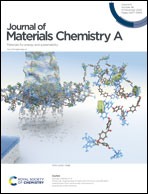Hierarchical porous carbon sheets for high-performance room temperature sodium–sulfur batteries: integration of nitrogen-self-doping and space confinement†
Abstract
Room temperature sodium–sulfur (RT Na–S) batteries hold great promise for next generation high energy storage systems due to their high theoretical capacity and the low cost of both sodium and sulfur. However, the slow reaction kinetics and insulating properties of sulfur, and dissolution of sodium polysulfides seriously inhibit their practical applications. In this work, a nitrogen-self-doped porous carbon (NPC) sheet is prepared through facile self-assembly, followed by a pyrolysis/activation process, in which polyvinyl pyrrolidone (PVP) simultaneously acts as a carbon and nitrogen source. Benefiting from the large specific surface area, abundant micro/nanoporous structure, and nitrogen-self-doping, the obtained NPC sheets can significantly boost space confinement for sulfur molecules and effectively alleviate the dissolution of sodium polysulfides during the charge–discharge process in RT Na–S batteries. As a result, the optimum sample (S@NPC-700) is used as the cathode of a RT Na–S battery, which delivers a specific capacity of 280.9 mA h g−1 (at 2.0C) and maintains a reversible capacity of 418.9 mA h g−1 at 0.5C after 400 cycles. The superior performance of the S@NPC-700 electrode can be attributed to the synergistic effect from the micro/nanoporosity of carbon sheets and nitrogen-self-doping.



 Please wait while we load your content...
Please wait while we load your content...